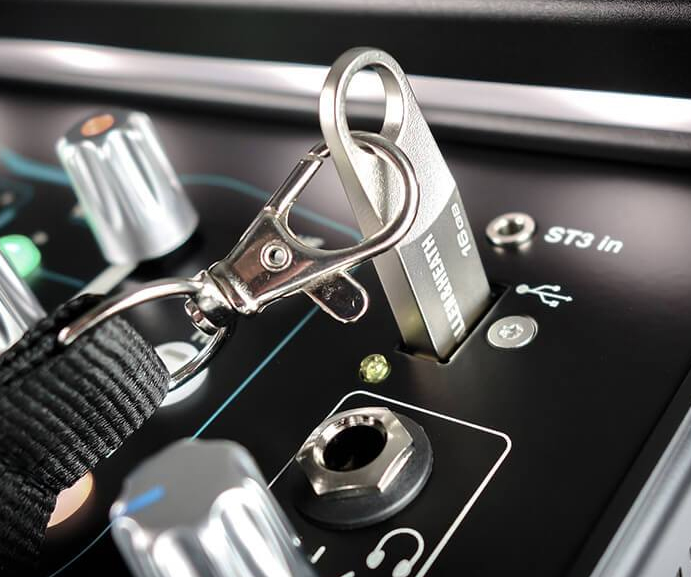Though much of my work consists of one-offs, I appreciate having the opportunity of a regular “down time” gig with a local classic rock band. Having mixed them for years, by this point it’s less like work and more like hanging out with friends and family. Reflecting on my work with the band, I found it interesting how the band’s musical growth, gear upgrades, and development of my own mixing skills led the showfile to evolve and change over time.
When I first took the gig, the input list was a simple “bar band” plot: vocal mics all around, DI for acoustic, plus a bass DI. In an effort to keep the levels under control in the rehearsal space, the guitar amps were rotated sideways (away from the listeners) and then miked to be reinforced through the rehearsal PA.
Once the band moved to in-ear monitors about two years ago, everything changed. The IEMs provided some much-needed isolation for the band members’ hearing, but of course that isolation meant more inputs. The input list grew to 20 to accommodate the full drum kit, bass, three electric guitars and one acoustic, stereo keyboard, and vocal mics all around.
As often happens with a move to IEMs, the band members were now accurately hearing their guitar tones for the first time and they weren’t happy. After some research, trial and error, we moved the lead and rhythm guitar rigs to load boxes that allowed them to get the desired tube saturation while keeping the stage silent.
The move was a great opportunity to revamp their pedalboards, optimize the gain structure and tonal balance, which cleared up the input processing on the console, leaving only high-pass filters on each. Bringing the faders up meant great, accurate guitar tones both in the IEMs and in the PA.
Mission Creep
As I adapted to mixing IEMs from front of house, I learned more about how to keep the artists comfortable in the in-ear environment. I double-patched all five of the vocal inputs, which allowed me to use a more neutral EQ and very little compression to create a more natural vocal response in the IEMs while still keeping things tight out front, and I could work freely on the vocal inputs from show to show, room to room, and PA to PA without disturbing the vocal sound on the IEMs. Five more inputs.
After consulting some of my mix engineer friends on the board mixes, I double-patched the lead guitar input to get some width out front, and took the opportunity to also double-patch the acoustic guitar input. I needed a pretty aggressive HPF and low-shelf cut to get the guitar to fit into the mix with multiple other guitars and keyboards, but the artist playing the guitar only has her own voice and acoustic in her IEMs, so it sounded thin to her. The double-patch allowed me to give her a fuller acoustic sound in her ears without getting muddy out front.

I also made some changes to the way I was handling effects, in order to keep a higher level of consistency in the IEM environment. In small rooms, my drum input faders often ended up very low, which meant that the drum sound in the IEMs would “dry up” from low post-fader send levels. I started running the drum reverb sends pre-fader.
Although I felt like I was breaking some cardinal rule of mixing by doing this, it worked – the send levels to the ears stayed rock steady, and I found that I was able to achieve a nice reverberant drum sound out front even when the inputs themselves were quite low, by riding the return fader. This was a great lesson for me – conventions and best practices exist for a reason, but it’s helpful to understand the underlying reasons, so we can understand when departing from them makes sense.
A Better Result
I also used a double-patched copy of the vocal reverb return for the IEMs. This was a little trickier – the pre-fader send trick wouldn’t work here because I use a mute group to mute the vocal reverb and tap delay in between songs. If a free effects slot had been available, I would have dedicated a reverb to the IEM mixes, but this was the next best option.
Double patching continued through the low end of the mix: the band uses a single kick mic, so I patch that into two inputs as Kick Low and Kick High, processed with crossover filters through the Midas PRO Series console’s onboard loudspeaker processor. This allows me to control the tonal balance of the kick with just fader moves rather than changing EQs.
It also lets me to use the high end of the kick for beater attack in the IEMs without bogging down the tiny drivers with the sub energy, which is unneeded due to the sub wash across the stage. I have a similar arrangement with the bass guitar inputs: a full-range input for the FOH mix and a version with reduced LF for the IEMs.
All told, the showfile in its current form is 33 inputs, but the flexibility created by that configuration means I have to adjust very little from show to show, either in the FOH mix or in the IEMs – for the most part, everyone plugs in and starts playing and is happy.
While I’m never an advocate of complexity for complexity’s sake, the measured and considered improvement over time in this case has led to a situation that gives me better results with fewer compromises – a very good thing indeed.



















